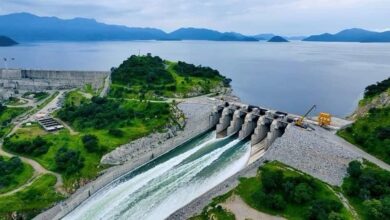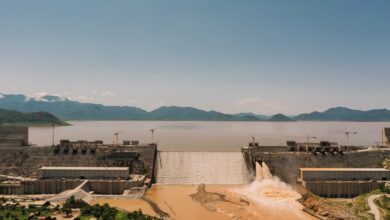Professor of Geology and Water Resources at the Cairo University Abbas Sharaky said that satellite images show that the flow of water from the top of the middle passage of the Grand Ethiopian Renaissance Dam has stopped, on March 15, as was expected.
“Ethiopia opened the two drain gates on Saturday March 12, after the failure of turbine No. 10, which was announced operational on February 20, to pass the increased water flow that crosses the middle passage, which amounts to about 30 million cubic meters per day during this period, as well as not operating the second turbine yet,” Sharaky said on a Facebook post.
He pointed out that the flow of water from the top of the middle passage has stopped because the discharge of these gates is about 30 million cubic meters at the current lake level (576 meters above sea level) as it shows its flow through the two drainage gates on the western side, and also shows the work of turbine No. 10.
Sharaky continued: “work may begin over the middle passage in the coming days after the water stopped.
It is therefore expected that the raise (in the passage) will be less than five meters this year, with a storage of about two billion cubic meters.
In the case of raising more than that, the two sides must also be raised to the same extent, which is difficult to implement during the remaining period.
He said that three and a half months remain until the flood begins and every meter that is raised at a length of about 1000 meters will store half a billion cubic meters.
Negotiations over the GERD have officially stopped since April 2021, after Egypt, Sudan and Ethiopia failed to reach an understanding before the start of the second filling of the dam, which Ethiopia implemented in July.
Cairo and Khartoum reject Ethiopia’s insistence on filling the dam before reaching a binding agreement on filling and operation.
Egypt, which relies considerably on freshwater from the Nile, has voiced fears that the GERD would negatively impact the country’s water supply.
Egypt has also insisted that measures be put into place to protect downstream countries in case of drought during the dam’s filling process.
Egypt and Sudan say they want a legally binding agreement, while Ethiopia says any pact should be advisory.
Egypt and Sudan consider the dam a threat to their vital water supplies, while Ethiopia considers it essential for development and doubling its electricity production.
The downstream nations fear possible blows to water facilities, agricultural land, and overall availability of Nile water.
Negotiations over the dam between Egypt, Ethiopia, and Sudan have stalled for years, with the three parties ultimately failing to reach any concrete agreement.
The disputed dam is the largest hydroelectric project in Africa, with a cost of more than four billion dollars. The construction of the dam began in 2011.
It is considered to be one of Egypt’s most serious water issues.


